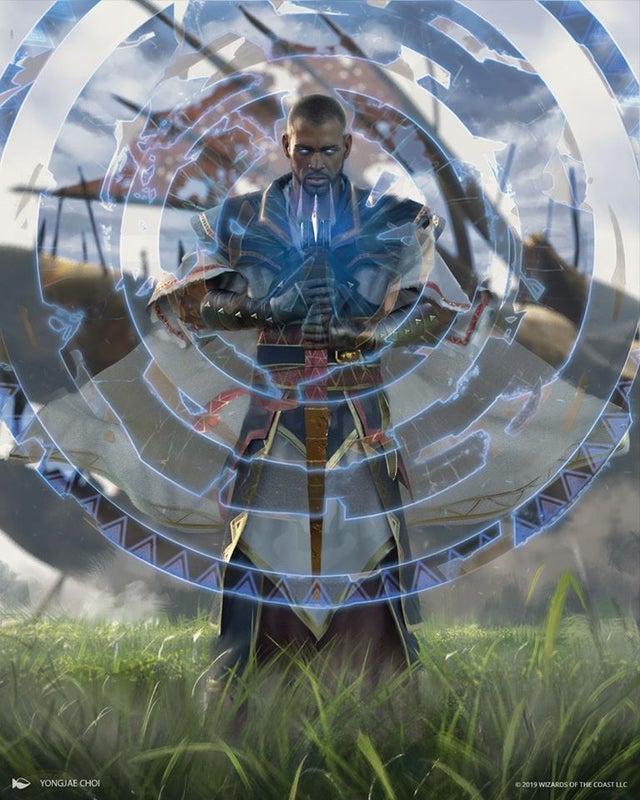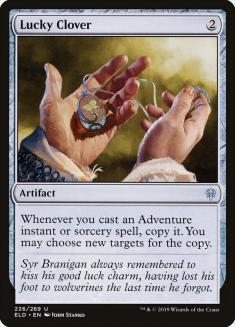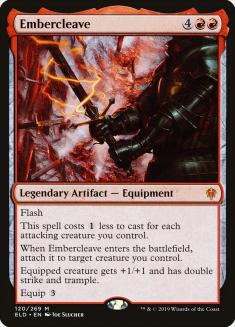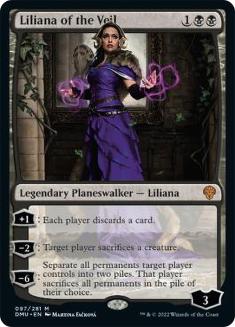It’s been a while since we had a Standard format that was nearly devoid of planeswalkers. Ever since War of the Spark, planeswalkers have been one of the main focuses of the format, defining every battlefield they find themselves on. That paradigm shifted with the release of Zendikar Rising, but it wasn’t just because of rotation. It was because the available planeswalkers weren’t as good as snowballing an advantage as a couple of other cards.
Omnath, Locus of Creation and Lucky Clover simply provided more of an advantage than most planeswalkers could dream to. Think about it: a planeswalker’s value is inherently tied to what it’s able to through its abilities. This value scales based on the number of turns it’s on the battlefield, because each turn cycle represents an additional activation, which means more value.
When comparing a single planeswalker to Omnath, Locus of Creation, it’s goofy to even pretend that planeswalkers are the thing to be doing. There isn’t a planeswalker that draws a card the first turn it’s on the battlefield, and then drains the opponent for four life and generates four mana every turn it sticks around. Did I mention that you can’t attack it down?
Lucky Clover had the capacity to do even more, and was more difficult to interact with. This completely gutted the incentives to register planeswalkers; they couldn’t win the fights they were picking.
Not anymore.
With Omnath, Locus of Creation and Lucky Clover banned in Standard, the format’s back in a place where planeswalkers have relevant text. Considering that before now, planeswalkers were either the be-all-end-all with Teferi, Time Raveler and Nissa, Who Shakes the World, or else were useless, it’s a refreshing middle ground.
With Standard getting a new lease on life, and the number of planeswalkers in the format being drastically reduced, it’s about time to look at the various roles they can play in the format.
The Generic Card Advantage Piece
We’ve all seen these before. This is the most common space for planeswalkers to occupy.
Creatures (30)
- 2 Scavenging Ooze
- 4 Lovestruck Beast
- 4 Edgewall Innkeeper
- 4 Bonecrusher Giant
- 4 Stonecoil Serpent
- 4 Gemrazer
- 4 Brushfire Elemental
- 4 Kazandu Mammoth
Lands (20)
Spells (10)

Proactive decks that are interested in having a grindy tool for matchups that are removal-heavy. Vivien, Monsters’ Advocate most commonly fills this slot in the aggressive green decks as Garruk, Primal Hunter crossed with Experimental Frenzy. These are also some of the easiest traps to fall into. After all, Vivien, Monsters’ Advocate is just good, right? Not always.
One of the most common things people will do whenever they’re building their decks is throw in a few planeswalkers in order to feel like they’re playing all the good cards they can. A lot of the time it’s simply wrong.
Take the above Gruul Adventures list, for example. In a deck without acceleration, Vivien isn’t really going to be worth the cardboard she’s printed on until Turn 6 at the earliest. Outside of a few matchups, that’s roughly when Gruul Adventures is trying to slam the door shut with Embercleave or a giant Gemrazer mutation. That’s why so many Gruul Adventures (and Mono-Green Aggro) decks will relegate Vivien to the sideboard – despite being a powerful card, she isn’t always playing to the deck’s gameplan.
That doesn’t meant there isn’t a place for this kind of planeswalker. It just means the deck has to intend to play for several turns after the time it expects the planeswalker in question to hit the battlefield.
Creatures (3)
Planeswalkers (3)
Lands (25)
Spells (29)

Dimir Control is the kind of deck that is planning to ride Ashiok, Nightmare Muse to victory. The key difference here is the length of game the deck plans to have after sticking its planeswalker. The value of a planeswalker comes down to what you’re trying to have it accomplish with the text on the card. “Planeswalker” has become a generic enough card type that it isn’t always going to be a card that’s trying to accrue advantages over a long game. That’s just the most common thing they’ve been used for as of late.
Closers
Another thing that planeswalkers are great for is putting the game out of reach. In a well-built deck, there’s generally going to be a common goal that all of the cards are building towards, with a payoff that slams the door shut when that goal is achieved.
Embercleave is the most bold-faced example of a card with clear incentives and rewards on the text of the card. Any deck playing Embercleave is trying to build a few medium-to-large creatures, and Embercleave the opponent to death with them. Simple enough.
Planeswalkers can do that as well.
Creatures (27)
- 4 Venerable Knight
- 4 Faerie Guidemother
- 3 Giant Killer
- 4 Ardenvale Tactician
- 4 Selfless Savior
- 4 Skyclave Apparition
- 4 Luminarch Aspirant
Planeswalkers (3)
Lands (21)
Spells (9)

In Mono-White Aggro, Basri Ket serves as a nail in the coffin – rather than building something after being on the battlefield for several turns, the one-two punch of Glorious Anthem into Basri’s minus ability gives the deck reach, which it’s sorely lacking otherwise.
Obviously that doesn’t mean that Basri’s other two abilities are completely irrelevant. It just means that in a deck like this, Basri is intended to be something closer to Launch the Fleet with upside, rather than a card that will win the game by itself. Slamming the door shut isn’t the only way to get paid by a planeswalker, however.
Sometimes it’s just good enough to keep the game perpetually out of reach.
Creatures (21)
- 4 Lotus Cobra
- 4 Beanstalk Giant
- 4 Bonecrusher Giant
- 1 Ilysian Caryatid
- 4 Llanowar Visionary
- 4 Terror of the Peaks
Planeswalkers (3)
Lands (23)
Spells (13)

Since the release of Core Set 2021, Ugin, the Spirit Dragon has warped the axis creature decks have to fight on. There’s certainly a point where that’s on the back of the ramp tools that are available, but that mostly just speaks to the incentives outlined by Ugin.
Rather than creating a situation that literally ends the game based on some sort of battlefield presence, like Basri or Embercleave, Ugin asks that the first few turns be spent on developing mana. Once the eight-mana threshold is crossed, the payoff is having a repeatable source of customizable removal that’s largely difficult for most decks to interact with.
This boils down to creating games where Ugin isn’t literally the card that will be dealing twenty points of damage to the opponent, but it is the card that marks the end-game, and the point of no return for the opponent.
Giving that free point of interaction actually sets Ugin, the Spirit Dragon close to the final kind of planeswalker in Standard: the double-spell enabler.
Double-Spell Enablers
There’s a class of planeswalkers that aren’t necessarily going to provide the game-ending level of card advantage that Vivien, Monsters’ Advocate will, nor are they going to mark the end of a game like Ugin. These are the planeswalkers that are largely trying to be worth a handful of spells over the course of a few turns, while mana is only invested in a single turn cycle.
Liliana of the Veil is the most famous example of a planeswalker in this vein. No individual ability on Liliana is going to be worth the three mana that’s invested into her. Her strength lies in the fact that that she provides her controller with a different kind of ability that’s worth a spell every turn.
These abilities tend to lean interactive, and the only reason that Ugin doesn’t fall into this category is because of how game-breaking his sweeper ability is. The biggest point for these cards is that they allow their casters to have a turn cycle later on where they answer the opponent’s card while also developing their own threat. This comes up the most in Rakdos Midrange:
Creatures (13)
Planeswalkers (2)
Lands (21)
Spells (24)

Rakdos Midrange is largely looking to play a fair, heads-up game of Magic, complete with normal one-for-one exchanges, and a couple of cards that end up winning the game when the dust settles. Liliana, Walker of the Dead is great for exactly that gameplan.
That’s because one of the biggest things that these kinds of decks tend to struggle with is falling behind on the battlefield and not being able to accrue enough favorable mana exchanges to catch back up. Having repeatable interaction each turn helps make it easier to avoid falling behind in that way and rewards wheel-spinning. This is because having a planeswalker that threatens to remove a creature for free on every third or fourth turn makes the average card an opponent draws weaker than the average card drawn by the controller of the planeswalker.
Teferi, Master of Time and Narset of the Ancient Way are more planeswalkers that fall in this category. One of the more defining characteristics that sets these planeswalkers apart from the likes of Vivien and Ashiok is that their first ability largely exists as a means to activate the second. That’s not to say their first abilities are useless, but people aren’t exactly excited to register a blue four-drop that doesn’t do anything but loot several times.
The generic card advantage planeswalkers have two or three abilities that all accrue some sort of advantage, rather than enabling a specific one repeatedly. The emphasis that double-spell planeswalkers place on their second ability means their role in almost any deck will revolve around it.
The overarching point of all of this is that planeswalkers aren’t the auto-includes in War of the Spark, and knowing what your deck is trying to do will inform whether or not you’re in the market for any planeswalkers at all. The answer isn’t a given, but the above framework is a great tool for deckbuilding around one of the most powerful card types in the game.






